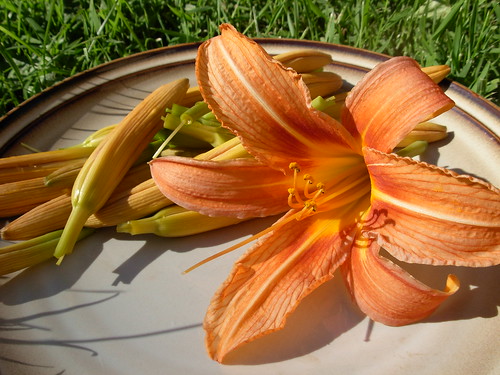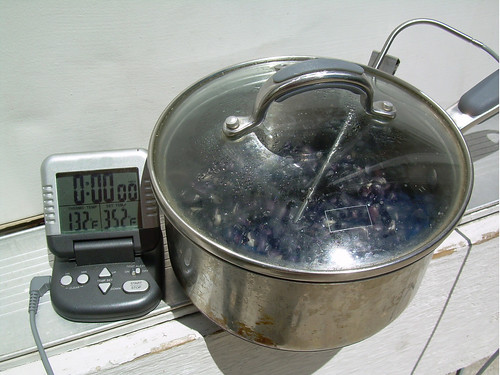 We moved into a new apartment, which has better solar access (read: worse shading) than the previous. I noticed that the aluminum threshold gets very hot, so I decided to throw on some turtle beans and do some impromptu solar cooking. It got up to 134°F, which I know is nothing compared to actual solar ovens. I'll still have to boil these, but the hot soaking will reduce the cooking time.
We moved into a new apartment, which has better solar access (read: worse shading) than the previous. I noticed that the aluminum threshold gets very hot, so I decided to throw on some turtle beans and do some impromptu solar cooking. It got up to 134°F, which I know is nothing compared to actual solar ovens. I'll still have to boil these, but the hot soaking will reduce the cooking time.
August 17, 2010
impromptu solar cooking
 We moved into a new apartment, which has better solar access (read: worse shading) than the previous. I noticed that the aluminum threshold gets very hot, so I decided to throw on some turtle beans and do some impromptu solar cooking. It got up to 134°F, which I know is nothing compared to actual solar ovens. I'll still have to boil these, but the hot soaking will reduce the cooking time.
We moved into a new apartment, which has better solar access (read: worse shading) than the previous. I noticed that the aluminum threshold gets very hot, so I decided to throw on some turtle beans and do some impromptu solar cooking. It got up to 134°F, which I know is nothing compared to actual solar ovens. I'll still have to boil these, but the hot soaking will reduce the cooking time.
August 16, 2010
boulder is getting a tool library
 (photo source: takomabibelot)
(photo source: takomabibelot)I'm excited that Boulder is getting a tool library. Our friends Libby and Tristan built their tiny house/gypsy wagon primarily using tools from a tool library in Santa Fe--proof that you can accomplish a lot without requiring your own woodshop and expensive tools! I'm hoping for a thickness planer I can use on salvaged wood.
Boulder's Tool Library is happening through the efforts of the Center for ReSource Conservation and Adam Jackaway, who went through the same graduate program as me. You can vote here every day until September 10, to help the idea win a $20,000 grant. Read more about the tool library: here.
And find one near you: List of tool-lending libraries.
July 31, 2010
pesto pizza & ramblings on local food legislation
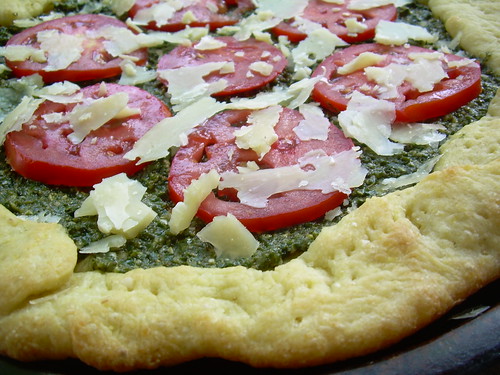 Yum! For dinner tonight, we made pesto pizza on a cornmeal crust, topped with our first tomatoes of the season and cheese from Windsor Dairy.
Yum! For dinner tonight, we made pesto pizza on a cornmeal crust, topped with our first tomatoes of the season and cheese from Windsor Dairy.Ingredients for large corn meal pizza crust:
2 1/2 c. all purpose flour
1 c. corn meal
1 T. sugar
1 t. dry active yeast
1/2 t. salt
2 T. olive oil
1 1/2 c. water
 Onto the rambling! Windsor Dairy is great. They sell excellent artisan cheeses made from local, organic, grassfed cow's milk. The cheeses are just the gateway. The REALLY cool thing about Windsor Dairy is that they offer raw, unpasteurized grass-fed cow's milk to the masses. The way they do this is a little complicated but it is still effective. In Colorado, legislation allows you to consume raw milk from a cow that you own. Windsor Dairy offers a "cow share" program, where you buy a share of a cow and then pay a monthly boarding and milking fee on that cow and in return you can consume a weekly installment of raw milk.
Onto the rambling! Windsor Dairy is great. They sell excellent artisan cheeses made from local, organic, grassfed cow's milk. The cheeses are just the gateway. The REALLY cool thing about Windsor Dairy is that they offer raw, unpasteurized grass-fed cow's milk to the masses. The way they do this is a little complicated but it is still effective. In Colorado, legislation allows you to consume raw milk from a cow that you own. Windsor Dairy offers a "cow share" program, where you buy a share of a cow and then pay a monthly boarding and milking fee on that cow and in return you can consume a weekly installment of raw milk.This is significant to Eric and me because when we started getting into local food in Illinois, we were shocked to find no small-time dairy operations. I mean surely there must still be a few devoted small farmers, right? The thing is, there are laws. To sell milk, you need to own a lot of expensive equipment to process and pasteurize the milk to government standards. The standards are often prohibitively expensive for small processors: "Get big or get out." It's crazy though because you honestly don't need to pasteurize milk if its fresh, local, and from healthy, grass-fed cows. In fact it is way better for you than pasteurized milk trucked to you from CAFO cows. So why is it that the consumer doesn't have the right to choose?? In Illinois, we did end up finding a guy who would sell us raw, grass-fed cow's milk. It was totally under the table and we did it because we're that kind of people, but the point is that it shouldn't be so convoluted for the regular person to sell or buy quality food.
While I am on the subject, the government doesn't just inhibit small dairy, they also inhibit small, local food processors (people who make granola, jams, pastries, pickles, sauerkraut, etc). Small economies have unfair competition with grocery stores thanks to all of our subsidies to agribusiness. As if that weren't enough, you need a license and a commercial kitchen to sell food. You can't just sell your excess jars of jelly or custom cakes occasionally. To sell, you basically need to make a business commitment. I mean you can sell, but it's not so legal. Even if you try to do everything right, the city of Chicago may still swing by and destroy your granola. Unlike Illinois, Michigan recently took a really positive step in this arena by approving a cottage industry farm bill. People selling less than $15,000 a year in goods in Michigan no longer need a license nor do they need a commercial kitchen. They just have to label what is in their product and who/where it came from.
In conclusion, it is time for us all to change local food legislation in our states!
July 23, 2010
cold brew coffee
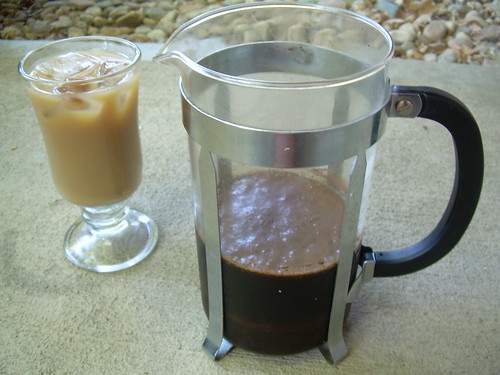 Cold brew coffee is great in the summer because you can make iced coffee without having to make hot coffee or espresso first. It's easy too. You just put coffee grounds and water in a french press and let it sit in the fridge overnight. Cold brewing makes a less acidic and smoother tasting drink than regular coffee. Supposedly it has less caffeine too...
Cold brew coffee is great in the summer because you can make iced coffee without having to make hot coffee or espresso first. It's easy too. You just put coffee grounds and water in a french press and let it sit in the fridge overnight. Cold brewing makes a less acidic and smoother tasting drink than regular coffee. Supposedly it has less caffeine too...We've tried two different water-to-coffee ratios:
2:1 - this concentration is good for mixing with milk or water. I actually used the same grounds four times before discarding them.Neither really stands out as a favorite, but 4:1 is less work.
4:1 - close to the usual french press ratio
I've also been enjoying a lot of cold yerba mate, which like coffee brews in cold water just fine. A french press works great for mate, as does the ol' jar + bombilla method.
July 19, 2010
egyptian falafel
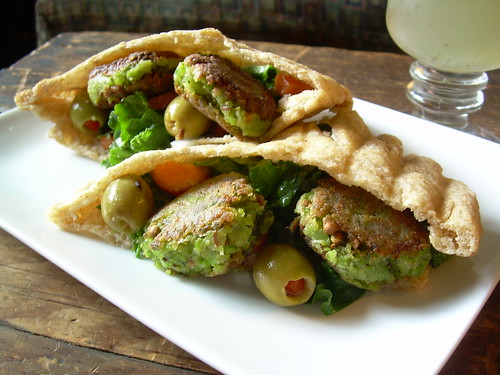 I bought fava beans at the market because I hear "it's the thing to do."
I bought fava beans at the market because I hear "it's the thing to do."After falling prey to this food trend, I decided to do some reading on the bean. Here's my favorite factoid - "These ancient beans are one of the oldest cultivated plants and among the easiest to grow. They were the only beans Europeans ate before they discovered America and all its legumes." (NPR article) I like that.
When I looked for meal ideas, I landed on Egyptian falafel... because regular falafel is delicious! Egyptian falafel is unique from everywhere else in the Middle East because it uses fava beans instead of chickpeas. Internet people make claims that Egyptian falafel is superior. I enjoy such claims so I went with it.
The only catch to these trendy beans is that there are 3 steps to process them. First you have to pop them out of the pods. Then you parboil them for a minute in some salty water. Finally you peal off the outer skin to reveal a bright green bean. After eating the Egyptian falafel, I've decided it's worth the effort.
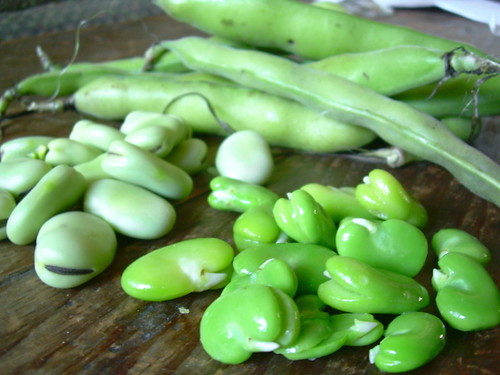
Serving Size: 12 small falafel balls
Egyptian Falafel Ingredients:
1 lb. fresh fava beans in the pod (1 c. shelled and skinned)
1/2 small onion, chopped
2 cloves garlic, chopped
2 T. parsley
1 t. cumin
1 t. coriander
1/2 t. salt
dash of cayenne pepper
1 T. flour
Toast the cumin and coriander in a dry pan. Put all of the ingredients except the fava beans in a food processor and blend. Add the shelled fava beans and pulse a few times until it reaches a desired consistency. Form balls. If you have time, let them sit in the refrigerator. Pan fry or bake.
I went all out and made homemade pita's using this recipe. We cooked them on the grill instead of in the oven to keep the heat in the kitchen down. To grill them, we coated the dough discs in olive oil, put them straight on the grill, and cooked them for 2-3 minutes on each side.
July 14, 2010
coleslaw
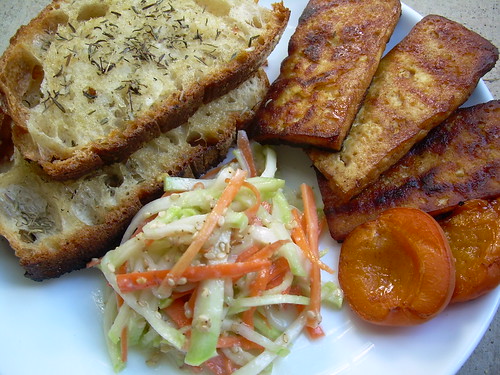 We got kohlrabi and carrots in our CSA. I couldn't resist slicing them up thin and making coleslaw. For the dressing, I used a recipe that Eric developed last summer. It's really good. While I was at it, I threw balsamic vinegar tofu, apricots, and garlic bread on the grill. We had ourselves a delicous summer feast!
We got kohlrabi and carrots in our CSA. I couldn't resist slicing them up thin and making coleslaw. For the dressing, I used a recipe that Eric developed last summer. It's really good. While I was at it, I threw balsamic vinegar tofu, apricots, and garlic bread on the grill. We had ourselves a delicous summer feast!
Coleslaw Dressing Ingredients:
1 T. yogurt
1 T. miso mayo
1 T. peanut oil
1 T. agave nectar
1 t. garlic powder or fresh clove
1 T. toasted sesame seeds
Mix together the ingredients for the coleslaw dressing. Slice or shred veggies like carrots, kohlrabi, cabbage, etc and toss them in the dressing. Let things sit in the fridge until ready to serve.
July 11, 2010
July 10, 2010
knowledge is power!
 I'm pretty excited about this switchplate with built in temperature and humidity sensors that I bought for my parents' bathroom. They had been having a problem with moisture from showers staying around too long, so I had them buy a new exhaust fan that actually exhausts the CFM that it's supposed to. Although the relative humidity sensor doesn't automatically control the fan, knowing the relative humidity can help you decide if you should manually run the fan for longer. For example, if the RH is 40% or higher and it is cold outside, you will probably get condensation on the inside of the exterior wall[1].
I'm pretty excited about this switchplate with built in temperature and humidity sensors that I bought for my parents' bathroom. They had been having a problem with moisture from showers staying around too long, so I had them buy a new exhaust fan that actually exhausts the CFM that it's supposed to. Although the relative humidity sensor doesn't automatically control the fan, knowing the relative humidity can help you decide if you should manually run the fan for longer. For example, if the RH is 40% or higher and it is cold outside, you will probably get condensation on the inside of the exterior wall[1]. The separate 3-way switch is also pretty cool: pushing it down makes the fan run for a preset amount of time, like 30 minutes, without requiring the bathroom light be on. Both the switch and the switchplate are available from EFI.
tiger lily flower buds
I remembered hearing somewhere that lily flowers are edible. My parents have a ton of tiger lilies in their yard, so I decided to try eating them. Most of the plant is edible including the small potato-like roots. When cultivated for the root, the unopened flower buds are removed to stimulate root growth[1]. This explains the presence of the flower buds aka "golden needles" in Chinese and Thai cuisine.
I battered and deep fried some of the flowers, and added the rest to a stir fry. When eaten raw, they have a slight peppery flavor.
On a side note, echinacea is growing everywhere in Illinois!
I battered and deep fried some of the flowers, and added the rest to a stir fry. When eaten raw, they have a slight peppery flavor.
On a side note, echinacea is growing everywhere in Illinois!
Labels:
deep fried,
edible flowers,
lily,
stir fry,
tiger lily,
wild
July 8, 2010
wedding season continued
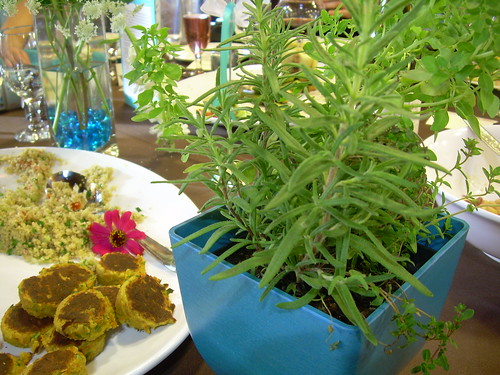 I was not kidding about it being wedding season. We went to central Illinois last weekend to celebrate the wedding of our friends Tom and Susan. (big smile)
I was not kidding about it being wedding season. We went to central Illinois last weekend to celebrate the wedding of our friends Tom and Susan. (big smile)The food at their reception was AMAZING. They had a thoughtful meal that featured lots of local, organic produce. If you happen to need catering in central Illinois, I would definitely recommend contacting Ben and Kate Lubchansky of Urbana's Community Supported Kitchen.
Oh and check out Tom and Susan's clever table decor - homegrown herb pots.
Subscribe to:
Posts (Atom)


